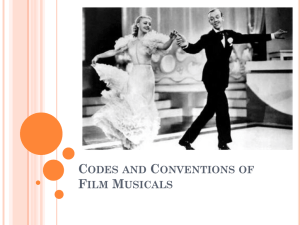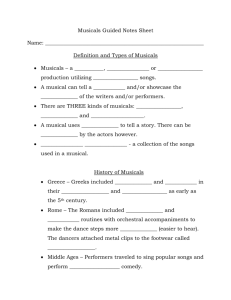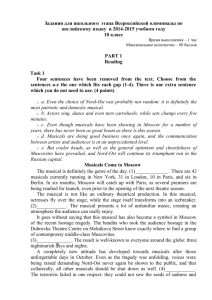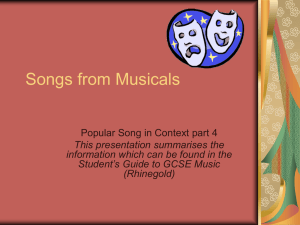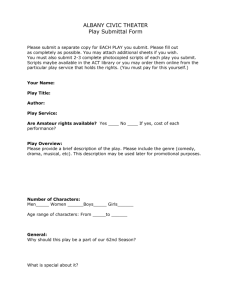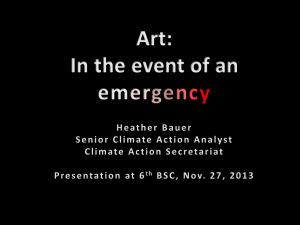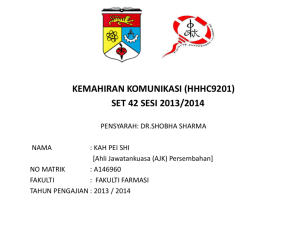Codes and Conventions of Film Musicals
advertisement
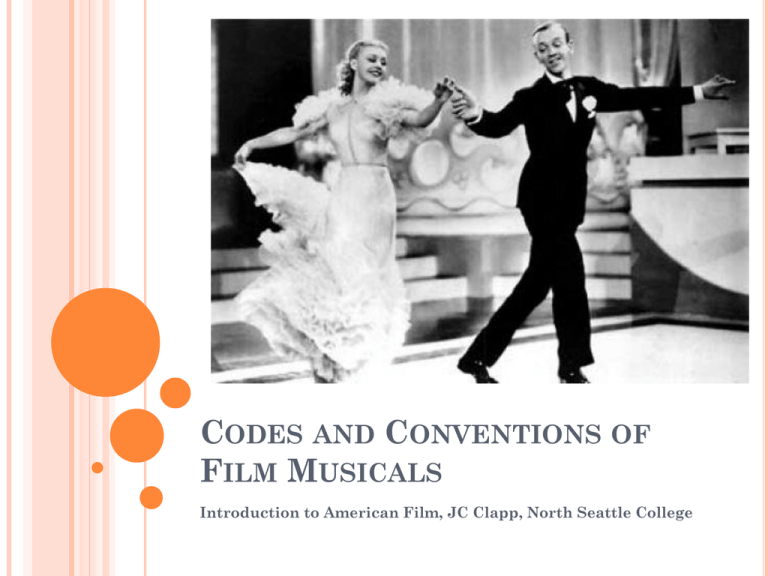
CODES AND CONVENTIONS OF FILM MUSICALS Introduction to American Film, JC Clapp, North Seattle College OVERALL STYLE & CHARACTERISTICS Songs sung by the characters to advance the plot or develop the film's characters or themes. Singing in a movie isn’t what makes a musical – for it to be a musical, characters must be uninhibited and outwardly express emotion through song and dance Rather than simply adding music to the soundtrack (non-diegetic), the characters within the film sing and dance to convey their thoughts and feelings (diegetic). MORE STYLE & CHARACTERISTICS Characters sing and dance to the camera, for the benefit of the film viewer, rather than any ostensible audience within the film's story. Musicals are always set in a fantasy world of some sort where music appears out of nowhere, where extras spontaneously act as back-up dancers, where everybody has a booming Broadway-style singing voice NARRATIVE AND THEMES Overall, musicals tend to be utopic and happy where good rules over evil – or where the protagonist prevails Whether the characters in musicals are feeling up or down, whether they are alone or in public, they are always able to fulfill their desire or to feel better by dancing or singing. MUSIC OF MUSICALS The musical accompaniment comes from "no where"— outside the world of the film—though the singing comes from within the world of the film, which is a violation of the rules of realism that govern almost all other genres/styles. Songs are usually “Broadway” style requiring big, powerful voices Singing originates from the mind and emotion of the characters – the songs are used to express inward thoughts and feelings outwardly SETTING Musicals have been set in many different times and places and are embedded in many other genres. Typically, there are big, lavish, colorful, over-the-top sets -the scenery can often change from a realistic picture to something more dreamlike. Often musicals look like they are set on a theatre stage – reminiscent of Broadway theatre musical productions CHARACTERS Male Lead: Protagonist, hero Female Lead: Protagonist, often the love interest of the male lead Villain: Usually an adult male, or often the conflict comes from the protagonist’s struggle against a life adversity (poverty, finding way home, unsympathetic family, forbidden love, desire for something unobtainable) Sidekicks: Side/ancillary characters that round out the narrative and support/thwart the protagonists AND NOW . . . AN INCREDIBLY BRIEF AND INCOMPLETE HISTORY OF AMERICAN FILM MUSICALS . . . 1920S: THE BEGINNING OF MUSIC ON FILM The Jazz Singer (1927) considered the first musical http://youtu.be/22NQuPrwbHA 1930S: NODS TO THEATRE AND STAGE Busby Berkeley’s (Warner Brothers) precision choreography was popular for making complex dance patterns such as in Dames (1933) http://youtu.be/MDe9upTQcpk 1930S: WHOLESOME FAMILY FUN Shirley Temple (20th Century Fox) at age six sang and danced her way into the hearts of Americans with films such as Curly Top (1935) http://youtu.be/wNwFXLcrsbc 1930S: CHOREOGRAPHY AND DANCE Ginger Rogers and Fred Astaire (RKO) were big stars known for their ballroom-style dancing abilities in films such as Top Hat (1935) http://youtu.be/mxPgplMujzQ 1940S: “THE FREED UNIT” (MGM) REIGNS Arthur Freed broke away from the old formula and made new films for MGM such as The Wizard of Oz (1939), Meet Me in St. Louis (1944), and Singin’ in the Rain (1952) http://youtu.be/D1ZYhVpdXbQ 1950S: RODGERS AND HAMMERSTEIN RISE Many theatre/stage productions adapted into musical films. Richard Rodgers and Oscar Hammerstein rose to fame by writing major hits such as Oklahoma! (1955) and South Pacific (1958) – set in everyday life Disney made many animated musicals such as Cinderella (1950), Peter Pan (1953), The Lady and the Tramp (1955) and Sleeping Beauty (1959) http://youtu.be/DBVqWSWPxlg 1960S: MUSICALS MAKE MONEY AND WIN AWARDS – AND ALSO FLOP BIG-TIME Musicals early in the decade were mostly huge successes: West Side Story (1961), The Music Man (1962), My Fair Lady (1964) Mary Poppins (1964), The Sound of Music (1965) – Julie Andrews was very popular http://youtu.be/HrnoR9cBP3o In the late 60s, with the predominance of rock music, most of the film musicals were commercial flops: Camelot (1967), Paint Your Wagon (1969) 1970S: ROCKIN’ THE BIG SCREEN Popular music took over film musicals: Jesus Christ Superstar (1973), Tommy (1975), The Rocky Horror Picture Show (1975), Grease (1978), Hair (1979) http://youtu.be/bc80tFJpTuo 1980S: SPARSE SELECTIONS Most of the few musicals made in the 80s were directed at children: Jim Henson’s Muppets made three full-length musicals (1979, 1981, 1984), and Disney revived its successful formula with The Little Mermaid (1989) http://youtu.be/FpRap-zHZHY 1990S: DISNEY’S NEW GOLDEN AGE Beauty and the Beast (1991), Aladdin (1992), Newsies (1992), The Lion King (1994), Pocahontas (1995), The Hunchback of Notre Dame (1996), Hercules (1997), Mulan (1998), Tarzan (1999) http://youtu.be/99Op1TaXmCw 2000S: BOLD AND POSTMODERN Only a few musicals were made, but they were bold, such as: Hedwig and the Angry Inch (2001), Moulin Rouge! (2001), 8 Mile (2002), Chicago (2002), Dreamgirls (2007), Sweeney Todd (2007) http://youtu.be/CJUr7jMpKTs MUSICALS IN A VARIETY OF GENRES/STYLES Western = Annie Get Your Gun, Oklahoma Mystery = Drood War = South Pacific, Hair Science Fiction = Little Shop of Horrors, Chitty Bang Bang Fantasy = Mary Poppins, Wizard of Oz Documentary = This is It Biography = Musical Biography of Quincy Jones Horror = Sweeney Todd Comedy = The Mask, Singin’ in the Rain Action/Adventure = Labyrinth, The Great Race Family Drama = The Sound of Music, Annie, Seven Brides for Seven Brothers, Newsies Teen = Grease, Hairspray, High School Musical, Westside Story Adult Drama = Dream Girls, Saturday Night Fever, Dancer in the Dark, Moulin Rouge!, Chicago Children = Cinderella, Alice in Wonderland, Peter Pan, The Lady and the Tramp, Sleeping Beauty
